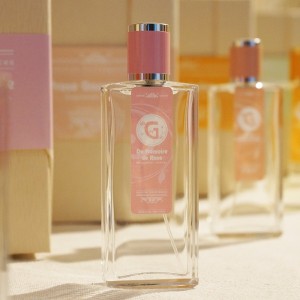
Evolution of the Perfume Bottle
During the 1900s to 1910s, the Art Nouveau style of art was very popular. Perfume vials were made from crystal and were ladylike, whimsical and floral in design. The lettering was usually gold and they had corked stoppers and brass caps. The majority had wands in order to apply the fragrance to the wrists or neck. During this time, atomizers came to life in which a woman could apply a fine spray using a bulb applicator. Manufacturers started creating empty vessels in order for “proper” women to store their favorite fragrance. Also during this time was the emergence of curvaceous bottles with glass flowers.
In the 1920s, with perfume being brought back with the soldiers at the end of the war, the expansion of fragrance sales prompted the need for companies to collaborate with fashion designers to create new vessels. Hollywood was an influence due to the rising success and glamour it eluded. Art Deco and urban inspired designs gained in popularity. A simple rectangular vessel with a glass topper was just as desirable.
 With the onset of the Great Depression in the 1930s, perfume sales drastically reduced. Those manufacturers that were able to stay open gave way to producing cheaper machine made bottles with eye-catching outer packaging.
With the onset of the Great Depression in the 1930s, perfume sales drastically reduced. Those manufacturers that were able to stay open gave way to producing cheaper machine made bottles with eye-catching outer packaging.
In the 1940s with WW2 winding down, the more creative fragrance package designs started to re-emerge. The public’s desire for elaborately designed artistic bottles led the way to paint, enamel, metal or plastic attachments in order to distinguish one fragrance from another.
As modern art movements like Abstract Expressionism and Surrealism began to ease their way into the mainstreams in the 1950s, artists sought out worthy patrons in the world of fragrance. Many of the perfume bottles during this time period were designed by fashion designers. While some were fashioned after a rock-n-roll band, others designed the toppers to mimic hats and crown of flowers.
The 1960s evidenced the return of craftsmanship and folk art. Handcrafted artisans and independent glass-blowing studios also began to emerge. This led to highly decorative and distinctive bottles, usually inspired by fashion for the decade.
In the 1970s, women were seen as strong and independent. Metal was re-introduced into women’s perfume decanters making them more unisex and utilitarian. The stoppers in some cases were replaced with screw tops allowing the fragrance to be applied more as a splash than a dab. This pared down design signaled the more liberal modern women could fit luxury into her life style.
1980s revolutionized the concept that perfume was a toiletry item and thus more portable with the introduction of the built-in atomizer. Plastic became more commonly used allowing women to carry perfume in their purse. This made the products more widely available to customers. Also during this time, the vials were made in heavy clear or black glass geometric shapes with gold metallic lids and other flashy details.
During the mid-1990s, the rise of outsourcing led to fewer containers being manufactured in the U.S. The more expensive fragrances were selling next to the lesser priced ones in stores. Construction of the perfume vessel was becoming more disposable.
Today, perfumers are testing bottle designs by using materials such as color-coated glass and light weight plastics. There are many celebrity and fashion designer fragrances emerging during this time which has led to more complex and bold features.
Ultimately, designers create perfume bottles to lure the public to their products by grabbing their attention.
Patti Zimmerman, a perfumista, writes articles on her experience and passion for fragrances. Bottles have changed with each decade from the ornate to simple. These are some of the reasons why people collect them as a hobby.
If you are one of those individuals we can fulfill your need for unique perfume bottles. But the perfume will be included. Check out our great selection of women’s perfume and men’s cologne. Visit our website today and take advantage of the savings.
Article Source: http://EzineArticles.com/9102062

Leave a Reply